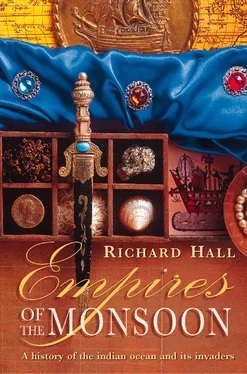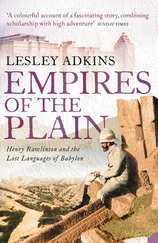The Abyssinians were also closely related to the people of Aden and its hinterland. Their forebears had crossed over the Red Sea in pre-Christian times, bringing with them from South Arabia an ancient written language they called Ge’ez , meaning ‘traveller’. (With the triumph of Islam that language had been replaced in its homeland by Arabic, just as the old religion – the worship of the sun, the moon and their divine son – had been obliterated.) There was a time when the Christian Abyssinians even invaded South Arabia, to punish the persecution of their co-religionists there; now they were on the defensive, retreating higher into the mountains to avoid the slave-raiders.
In their centuries of expansion the Arabs had needed vast amounts of slave labour to build their cities, tend their plantations, work in mines and dig canals. It was not a system of their own devising, for the economies of Greece and Rome had also relied upon slavery, and the use of forced African labour has a history going back 5,000 years. The first hieroglyphic account of contact between the Egyptians and their black Nubian neighbours beside the Upper Nile was inscribed on a rock by King Zer of Egypt’s first dynasty (before 3000 B.C.). Vividly illustrated, this shows a captive Nubian chief lashed to the prow of an Egyptian ship and the corpses of his defeated followers floating in the river. Five centuries later, the fourth-dynasty king Sneferu recorded that he had raided Nubia and brought back 7,000 blacks and 200,000 head of cattle. Slaves were used to help build the Pyramids.
In his time the Prophet Muhammad had laid down precise rules about the ownership of unbelievers, but the Qur’ān does not explicitly forbid it. The most common fate for the captive Zanj and Abyssinians was transportation across the Indian Ocean to the Persian Gulf and Basra, where they were brought ashore to be sold as labourers. After their long sea journey, during which they were manacled and subdued with whips, they were led from the waterfront between tall houses, past mosques where all men were equal, through streets crowded with donkeys, pack-horses and camels, to the slave market, the suq al-raqiq .
According to the African regions from which they came, the slaves were given group names, mostly no longer identifiable: Kunbula, Land-jawiyya, Naml, Kilab. Those who managed to survive longest learned some Arabic, acquired Arab names, and acted as interpreters, passing on orders to their compatriots. More fortunate were the ones bought to become personal servants, for there was the chance that a kind master might one day make them free. Then colour ceased to matter and they became part of the great community of Islam.
Most pampered of all African slaves were the eunuchs named by al-Muqaddasi as being one of Aden’s main imports. At the time he was writing there were 11,000 eunuchs in Baghdad, 7,000 of whom were Africans. A century earlier the caliph al-Amin had a vast corps of eunuchs; some white, whom he called his ‘locusts’, and some black, whom he called his ‘ravens’. Those who especially gratified the caliphs rose to gain immense power, and the Spanish-born traveller Ibn Jubayr was disgusted when he visited Baghdad to find the army controlled by a young black eunuch named Khalis: ‘We saw him one day going forth, preceded and followed by officers of the army, Turkish, Persians and others, and surrounded by about fifty drawn swords in the hands of the men about him … He has palaces and belvederes beside the Tigris.’ In other ways liberal-minded, Ibn Jubayr despised the blacks, observing: ‘They are a breed of no regard and it is no sin to pour maledictions upon them.’
In his memoirs the Persian sea-captain Buzurg ibn Shahriyar turns repeatedly to tales of adventure in the Land of Zanj (with many hints that he writes from personal experience), and slavery is the subject of the most telling of all his stories. Behind its improbabilities lies a realism which vividly evokes the world in which he lived, and he shows a remarkable sympathy towards the principal character, an African chief. The narrator is a wealthy shipowner called Ismailawayh, who has sailed to every part of the Indian Ocean, but knows Africa especially well. In the year 922 he is on a voyage to Qanbalu (the main town on Pemba island, just north of Zanzibar), but storms drive his ship far to the south, towards Sofala. It is swept on to a notorious stretch of coast where the crew fear they are going to be captured and killed or, worst of all, eaten. 5
On shore, the reception given to the strangers proves far better than Ismailawayh had dared to hope. The chief of the region, ‘a young negro, handsome and well made’, questions them, and says bluntly that he knows they are lying when they claim it had always been their intention to visit his country. But he promises them that they can trade freely, and will not be harmed. After doing good business the shipowner and his crew return to their vessel; the friendly chief, with several of his men, even comes on board to see them off. At this point Ismailawayh reveals his scheme: he will kidnap the unsuspecting blacks, carry them back to Oman, then sell them into slavery.
So as the ship begins to move and the puzzled chief and his men vainly try to get back into their canoes secured alongside, the Arab traders tell them what their fate is going to be. The chief replies with dignity: ‘Strangers, when you fell upon our beaches, my people wished to eat you and pillage your goods, as they had already done to others like you. But I protected you, and asked nothing from you. As a token of my goodwill I even came down to bid you farewell in your own ship. Treat me as justice demands, and let me return to my own land.’
His pleas are ignored and he is pushed down into the hold of the ship with other prisoners: ‘Then night enfolded us in its shrouds and we reached the open sea.’ During the journey northwards, across the equator and into the Arabian Sea, the kidnapped chief never speaks a word, and behaves as if his captors are totally unknown to him. When the ship reaches port he is led away into a slave market and sold, together with his companions.
That seems like the end of a profitable piece of business for Ismailawayh. But some years later he is once again sailing down the Zanj coast with his regular crew and another storm drives them on to the same stretch of shoreline. The ship is quickly surrounded and the crew are marched away to be paraded before the local chief. To their horrified astonishment, the very man they had sold into slavery long ago is seated there once more on the chief’s chair.
‘Ah!’ he says, ‘here are my old friends.’
Ismailawayh and his sailors throw themselves on the floor, and are afraid to look up. ‘But he showed himself gentle and gracious until we had all lifted up our heads, but without daring to look him in the face, so much were we moved by remorse and fear.’ The chief tells them a remarkable story, of how he had been taken as a slave to Basra, then to Baghdad. From there he had escaped from his Arab master, had gone to Mecca, and finally arrived in Cairo. Seeing the Nile, the chief had asked where it flowed from, and was told: the Land of Zanj. He decides to follow its course, in the hope of reaching his homeland. After many adventures in the interior of Africa he succeeds. The first person he meets is an old woman, who does not recognize him but says the witch-doctors have divined that the country’s lost chief is still alive and in the land of the Arabs. At that the wanderer goes joyfully back and reclaims his throne.
The chief tells his former captors that during his years as a slave he became converted to Islam. That is why he has decided to show magnanimity towards them; indeed, thanking them for being the cause of his conversion. But when they start preparing for their voyage back to Arabia, he lets them know that he cannot trust them too far, even though he is now a fellow-Muslim.
Читать дальше












